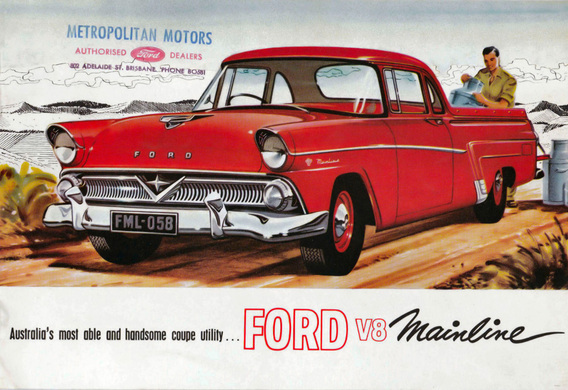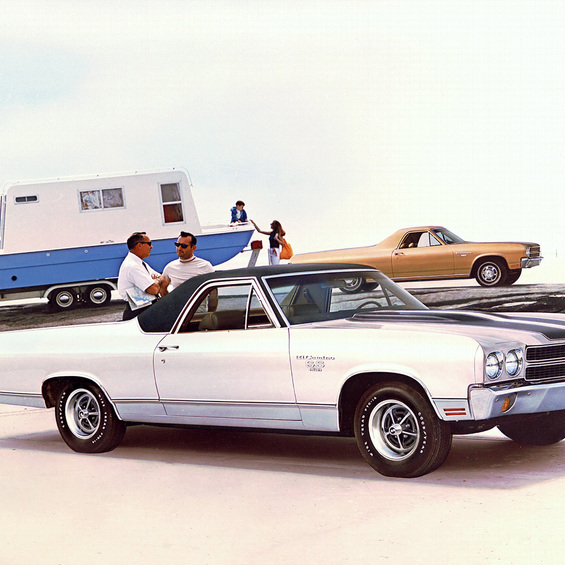
Ut. History and Modernity
Utah is a light commercial vehicle, which is a "hybrid" of the sunken truck and a lightweight. The first and full name of the body type is Coupe utility (the conversational abbreviation of Australians), since the front part of the car was originally borrowed from a two-door compartment or sedan. In fact, it is half of a lightweight, combined with a cargo tank. The markets of Australia and New Zealand are popular.
Ut. History of appearance
The first cosiness is connected to the Australian arm of Ford. In the 1930s, banks issued loans to local farmers for the purchase of trucks, but not passenger cars. The idea of creating a car that could be used as a "workhorse" and a full-fledged car for travel was created in the sub-soil of Ford. In addition, with the advent of the cosy, the story of how the engineers of the Australian Ford unit received a letter from the wife of a farmer from Victoria. The woman asked to create a car on which "on Sundays it is not shameful to go to church, and on Mondays it is possible to take it to the market of hogs".
The design of this project was taken by designer Lew Bantt, and two years later the model of the Ford Coupe Utility was presented to the general public-the first car in the world. It was initially perceived by villagers as an unaffordable luxury, but very soon became popular as a perfect car for farmers and traders. In the 1930s, the Australian Ford unit also released an open version of the model, which was called Roadster Utility.
Most famous models with bodywork
In 1951, the company Holden, the Australian structural subdivision of General Motors, introduced its cosy sedan 48-215.

For a long time, the cozies remained a commodity exclusively of the Australian market. Before the Americans, the first car with this body came in 1957, it was the Ford Ranchero (platform from Fairlane). In two years Chevrolet, not wanting to keep up with its competitor, offered its customers a cosy-El Camino (in 1978 the market also got its "twin" GMC Sprint, later renamed into the GMC Caballero). It was the one who subsequently became a cosy of cosiness around the world. The car was created on the Chevrolet Brookwood estate car platform. In the Chevrolet model, this was the first pickup truck with metal (not wooden, as before) a cargo platform and a corrugated sheet metal floor.
The most famous Asian cosy is the Subaru Brumby, created on the basis of the second generation of the compact sedan Leone. This model was created in Japan, but never sold there. In the markets of different countries Subaru Brumby (it is BRATs, Shifter, MV and Targa) was present from 1978 to 1993. The most famous owner of this Japanese coacht was US President Ronald Reagan: for 20 years, the car faithfully served him on a ranch in California. In 2005, the president's home was auctioned off.
In the 1980 ' s, the popularity of the coachbody's coachwork was decreasing, many models were retired (among them legendary Ranchero and El Camino). Such machines are still in high demand only in Australia and New Zealand. Ford and Holden are still specialized in the production of cozies.
However, in our time car manufacturers sometimes turn to this type of bodywork. For example, in 2011, BMW announced the entry into the world of the world's fastest sedan-built M3 sedan with a 4-litre 420-strong V8 engine. True, the release of this model was released on April 1 ... Naturally, this early April project did not go into the series, but one copy of the unique cosiness was created for authenticity.
Modern cots and their exploitation
The term "cosy" is now used mainly in Australia and New Zealand. However, it has changed over time. If initially called a light truck "blind" from the front part of the compartment or sedan and the body, now this is often referred to as all pickups and vans (for example, Mazda BT-50 won the 2012 Car of the Year award in the Best Ute nomination).
One thing that remains in the definition of a cosiness is that it, as before, implies universality, as well as the comfort level of the passenger car combined with the carrying capacity and the capacity of light truck.
Like the pick-up in Europe, the cozies in Australia and New Zealand can be divided into compact, medium-sized and full-size. If the first cots were exclusively two-local, there is now a tendency to increase the passenger space, so modern cots may be semi-thorns (with "cut" second row of seats), and in rare cases and double (with full second rows of seats).
Initially, there is an open body, but to increase the level of practicality and protection of cargo from air precipitation and theft, additional equipment or cover is used.
Due to its original appearance, the cots are often a source of inspiration for the tuning masters. In Australia and New Zealand, it is quite often possible to meet the "charged" powerful engine, the enhanced suspension and the aggressive weight. Special competitions and festivals are held for such "monsters". One of the biggest festivals for home owners is the Ute Muster, which hosts the car races and exhibitions of this class. In addition, there is a special race series V8 Ute Racing Series in Australia, in which the only "charged" quarters of Ford and Holden are involved.







